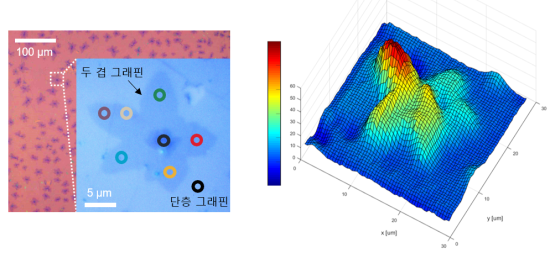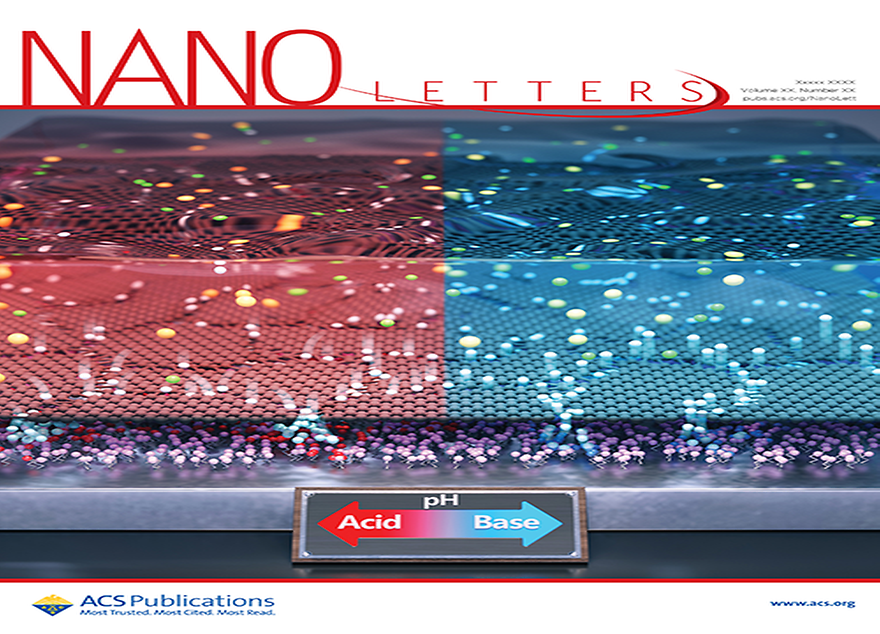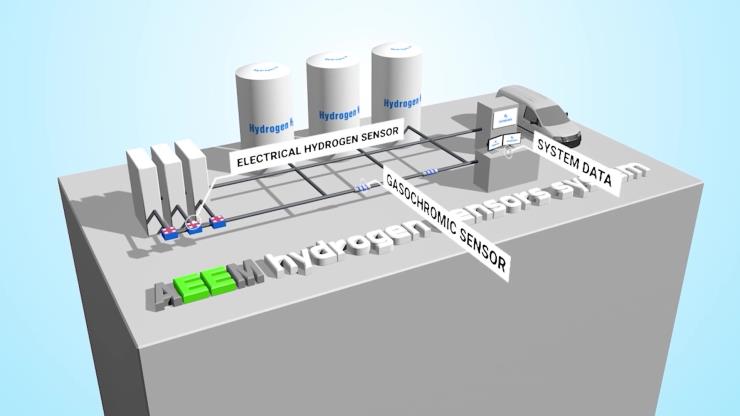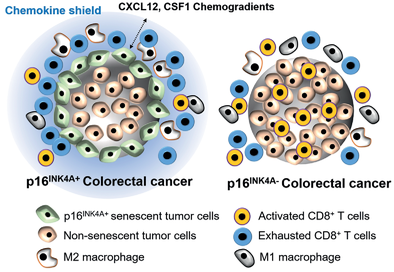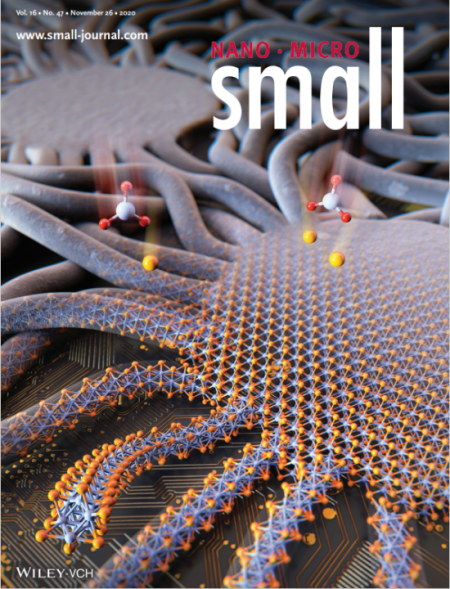-
A team of Ajou University researchers has uncovered a new optical phenomenon in graphene, widely regarded as a material that holds the key to the future. The team’s findings are expected to pave the way for developing new applications, including superspeed optical signal processing using two-dimensional materials, quantum communications, and quantum sensing.Prof. Yeom Dong-il (Departments of Physics and Energy Systems Research, pictured left) and his team have discovered that interlaying two stacks of single-layer graphene can produce considerably more nonlinear optic signals. Their findings were published under the title, “Enhanced third-harmonic generation by manipulating the twist angle of bilayer graphene,” in the January 21 online issue of Light: Science & Applications (IF = 13.714, IF (%) = 2.577).The paper lists two of Ajou’s doctoral students, Ha Seong-ju (pictured middle) and Park Nam-hun (pictured right), as first authors. The credit also goes to Profs. Lee Jae-hyun (Department of Materials Science and Engineering), Yoo Young-dong (Department of Chemistry), Park Ji-yong (Department of Physics), and Ahn Kwang-jun (Department of Energy Systems Research), as well as Prof. Jung Je-il (Department of Physics) from the University of Seoul.Graphene, a two-dimensional material well known for its composition of pure carbon atoms, has been garnering much attention around the world for its high conductivity and transparency as well as flexibility—all the properties desired in next-generation materials for electronic and optical diodes. Stacking layers of single-layer graphene at an angle produces Moiré superlattices. Graphene has recently captured researchers’ attention as the angle at which these layers are stacked can produce dramatically different results, including both a superconductor with zero resistance and a perfect insulator. The Moiré pattern refers to superlattices that emerge with much greater frequency than with the original and denser patterns of nets or fabrics layered together at an angle.Prof. Yeom’s team seized upon the nonlinear optic phenomenon that occurred when strong light was projected onto their twisted bilayer graphene (tBLG). The Moiré superlattices of the tBLG, in particular, gave rise to van Hove singularities (i.e., points at which the state density function of electrons peak-like discontinuities) with the state density of electrons. Moreover, the team discovered that, when the energy gap between the van Hove singularities tripled the energy of light being projected, significant enhancement occurred in the third-harmonic generation (THG) efficiency. Based on this finding, the team was able to increase the nonlinear optic signals of the electrically controlled tBLG by as much as 60 times those of single-layer graphene.Prof. Yeom commented: “With this study, we became the first in the world to demonstrate that the angle at which graphene is stacked can be a new significant variable when it comes to controlling and enhancing the nonlinear optic properties of two-dimensional materials. I expect that our findings will contribute to the development of new superspeed optical signal processing techniques or quantum lighting sources that utilize the nonlinear optic properties of two-dimensional materials.”The study was conducted with support from the National Research Foundation of Korea’s Experienced Researcher Support Program and Korea Energy Technology Evaluation and Planning’s Energy Workforce Development Program. Left: An optical microscope image of twisted bilayer graphene. The different colors represent the areas of graphene layers stacked together at different angles of rotation/twisting. Right: The third-harmonic generation image of bilayer graphene.
-
30
- 작성자OIA
- 작성일2021-03-19
- 6897
- 동영상동영상
-
A joint team of researchers from Ajou University and Sungkyunkwan University has developed an ultra-sensitive graphene ion sensor using a novel acidity-detecting mechanism. This groundbreaking discovery, which transcends the theoretical limit expected of such sensors, is expected to have various applications, including for Internet-of-Things (IoT) devices and diagnostic equipment.The team, co-led by Prof. Lee Jae-hyun (Dept. of Materials Science and Engineering / Graduate Dept. of Energy Systems Research) of Ajou and Prof. Whang Dong-mok of Sungkyunkwan, published their findings under the title “Super-Nernstian pH Sensor Based on Anomalous Charge Transfer Doping of Defect-Engineered Graphene” as the featured article in the January 13 issue of Nano Letters (IF = 11.238), a prestigious journal on nanoscience and technology. Both professors were featured as the corresponding authors, with Dr. Jung Su-ho of Sungkyunkwan’s Advanced Institute of Nano Technology as the first author, and Hyun Sang-hwa, a graduate student in Ajou’s Dept. of Energy Systems Research, as a co-author.Thanks to its high conductivity and the exposure of its components on the surface, graphene has been garnering much attention as an ideal material for sensors. The low surfactant reactivity due to the low defect density, however, makes it difficult for the substances to be detected—ions, molecules, etc.—to attach to the graphene.Until recently, much of graphene research has therefore focused on inducing and increasing defects on the surface of the material so that other materials may be better absorbed by it. This increase in mechanical defects, however, also compromises the desirable qualities of graphene, preventing researchers from transcending the theoretical limit on sensitivity.Prof. Lee and his team have sought to overcome this dilemma by controlling the density of nuclei formed in the early stage of graphene synthesis so as to control the shape and size of the grains found on the resulting product. This nuclear growth density control method has enabled the researchers to produce a nanocrystalline graphene with engineered defects so as to permit the selective penetration by ions. In other words, the team has come up with a novel detection mechanism utilizing the reaction between graphene-penetrating ions and the substrate underneath.As a result, the team has developed a highly sensitive nanocrystalline graphene-based pH sensor that is capable of achieving a sensitivity as high as 140mV/pH under optimized conditions, far exceeding the marginal sensitivity of 59mV/pH associated with conventional pH sensors.Emphasizing that they were the first in the world to find a new sensing mechanism capable of transcending the theoretical sensitivity limit, Prof. Lee and his team assessed that their defect-engineered nanocrystalline graphene harbors much potential for producing “highly sensitive semiconductor ion sensors with possible applications in IoT and medical devices.”This study was made possible with the support of the research support programs for basic research labs and seasoned researchers provided by the National Research Foundation of Korea.Sensing mechanism of the nanocrystalline graphene pH sensor*Gr = graphene, nc-Gr = nanocrystalline grapheneChanges in the nanocrystalline graphene pH sensor’s sensitivity with different substrate conditionsFeatured on the cover of Nano Letters
-
28
- 작성자OI***
- 작성일2021-02-23
- 5751
- 동영상동영상
-
A team of researchers led by Ajou’s Prof. Seo Hyung-tak has successfully developed a high-precision sensor capable of detecting high concentrations of hydrogen. The researchers expect their work to help enhance the safety of hydrogen energy, supporting the production and application of hydrogen in the future.Prof. Seo (Dept. of Materials Science and Engineering / Graduate Dept. of Energy Systems, pictured) and his team have invented a high-precision hydrogen sensor capable of detecting hydrogen at all levels of concentration, from particles per million (ppm) to 100 percent, using a new material created by combining an ultra-thin, multilayered, alloyed catalyst and electrodes. Their discovery was published in a paper entitled “Confined interfacial alloying of multilayered Pd-Ni nanocatalyst for widening hydrogen detection capacity” in the January 1 online issue of Sensors & Actuators B: Chemicals, an international journal on sensing technology. Dr. Lee Young-Ahn and Dr. Le Thai Duy, both of Ajou University, were featured as the co-first authors. The team also included Prof. Kim Hyun-you of Chungnam National University and Dr. Park Ju-cheol of the Gumi Electronics and Information Technology Research Institute.The range of possible applications of hydrogen as an alternative source of energy for automobiles, electricity generation, and other industries has been expanding rapidly as of late. The growing demand for hydrogen fuel cell vehicles, in particular, highlights the importance of developing hydrogen applications for eco-friendly transportation. Safety, however, has been a chief issue hindering the rapid growth of hydrogen as a fuel. An odorless, colorless substance that is also extremely lightweight, hydrogen carries a significant risk of undetected leakage. It does not take much to trigger an explosion when the hydrogen concentration in the surrounding air reaches four percent. Because extremely high pressure is crucial to ensuring the high energy intensity (energy stored per unit volume) required of hydrogen as a fuel, it is critical to equip hydrogen-powered vehicles and other such machinery with well-functioning hydrogen detectors.Furthermore, to diversify the possible use of hydrogen for purposes including fuel cells, it is essential to have a device capable of monitoring and controlling the purity and concentration of hydrogen. High-precision sensors capable of monitoring high concentrations of hydrogen (95 to 100 percent) are in particularly high demand. Such high-concentration hydrogen sensors, however, can be very complex to develop. There are only a handful of expensive options available on the market worldwide today. None of the existing products, furthermore, are able to detect a wide range of hydrogen concentrations ranging from ppm levels to 100 percent.With the goal of finding a high-precision, highly reliable alternative to the palladium (Pd) catalyst electrodes that are widely used in the conventional chemically resistant hydrogen sensors, the Ajou researchers have developed a new electrode by layering ultra-thin films of Pd and nickel (Ni) in a lattice-like fashion, with each layer having a thickness on the nanometer scale. Numerous existing structures using either a Pd film or nano-Pd structure are capable of detecting hydrogen at limited and low concentrations, but have proven hopelessly incapable of detecting hydrogen at concentrations of 50 percent or above. The hydrogen atoms decoupled from hydrogen molecules by the Pd fail to desorb from Pd lattices, thereby saturating the hydrogen signals, while repeated hydrogen detection also hydrogenates the Pd film or structure, destroying the catalyst.Prof. Seo and his team’s ultra-thin Pd-Ni interfacial super-lattice is capable of detecting high concentrations of hydrogen with incredible precision. It has indeed demonstrated top-notch performance at all levels of concentration (linearity = 95 to 99 percent, response time of less than three seconds, and signal variation of one percent or less). The new sensor even stably maintained its high performance throughout the repetitive accelerated durability test (hydrogen detected 40,000 times), a key step before the manufacture of hydrogen fuel cell parts. Furthermore, the team has demonstrated, through atom-level calculations and ultra-high-resolution transmission electron microscopy (TEM), that the success was entirely due to the structural stability of the Pd-Ni nano-surfactant alloy (only two to three nanometers in thickness) and its ability to reduce the energy required for hydrogen desorption.Prof. Seo’s team unveiled its latest invention at Consumer Electronics Show (CES) 2021, an exposition of today’s most cutting-edge technologies. Due to the pandemic, this annual IT and appliance industry expo, the largest of its kind in the world, was held exclusively online from January 11 to 14 this year.Prof. Seo explained: “Korean companies are solidifying their leadership in hydrogen fuel cell vehicles now that the demand for hydrogen energy is growing worldwide. Nevertheless, these companies have had to rely on very expensive and imported hydrogen sensors in order to ensure the safety of their products.”He added: “We are working on developing additional technologies to ensure the broad application of our new invention to hydrogen monitoring systems. Such systems have a wide array of potential applications in all hydrogen-using industries and sectors, including energy infrastructure, semiconductors, and petrochemicals.”The team’s study was made possible with the support of the Energy Technology Development Program of the Ministry of Trade, Industry and Energy and Korea Institute of Energy Technology Evaluation and Planning, as well as the Research Support Program for New Researchers with Advanced Overseas Accomplishments, Basic Research Support Program, and BK21 Four Program of the Ministry of Science and ICT and National Research Foundation of Korea. The team has been granted a patent for their sensor in Korea, and their applications for patents worldwide are in progress.Image of Prof. Seo Hyung-tak and his team’s hydrogen sensor shown at CES 2021
-
26
- 작성자OI***
- 작성일2021-02-23
- 5631
- 동영상동영상
-
A team of researchers led by those affiliated with the Ajou School of Medicine has demonstrated the existence of a chemical shield that protects tumor cells against attacks by immune cells, revealing a pathway to a new potential tumor treatment strategy.The team, led by Prof. Park Tae-jun (Dept. of Biochemistry and Molecular Biology), Prof. Kim Jang-hee (Dept. of Pathology), and Prof. Choi Yong-won (Dept. of Oncology-Hematology), has found that senescent tumor cells found in colorectal cancer serve to prevent immune cells from infiltrating the tumor, rendering them ineffective and thereby promoting the progression of colorectal cancer. The team’s findings were published in a paper entitled “Senescent Tumor Cells Build a Cytokine Shield in Colorectal Cancer” in the January 4 issue of Advanced Science.Senescent cells no longer grow and multiply, but still secrete a variety of substances. Micro-environmental changes associated with diverse illnesses have been attributed to the strong metabolic activities of these senescent cells. Until now, however, little had been known about how these old cells affect cancerous growths.Having verified the presence of senescent tumor cells in a surgically extracted specimen of colorectal cancer, the Ajou researchers observed that, the greater the number of senescent tumor cells found in a specimen, the slower the penetration of cytotoxic T-cells. The researchers also assayed the secretions found on the surfaces of senescent tumor cells and identified two specific cytokines responsible for the function of immune cells.The researchers demonstrated that CXCL12, a chemokine, inhibits the infiltration of cytotoxic T-cells into tumor cells, while CSF1, a cytokine, catalyzes the differentiation of macrophages that induce this immunosuppressant effect, thereby undermining the functioning of cytotoxic T-cells. They also found that, by inhibiting CXCL12 alone in mice with colorectal cancer, cytotoxic T-cells infiltrate the tumor cells far better, significantly inhibiting tumor growth.Concluding that senescent tumor cells in colorectal cancer can affect the progression of the cancer, the researchers expressed hope that their findings will “aid research and lead to the development of a new treatment strategy for colorectal cancer, which is quite resistant to immunotherapy, by targeting senescent tumor cells or the secretions they produce to inhibit immunotherapy.”This study was made possible with the support of the University-Centered Research Lab Support Program and Basic Research Program of the Ministry of Education, the National Research Foundation of Korea (NRF), and the Bio and Medical Technology Development Program (for the Enhancement of Clinician Scientists’ Research Capabilities) of the Ministry of Science and ICT and the NRF.Immunosuppressant function of senescent tumor cells in colorectal cancer# Pictured from left to right: Prof. Park Tae-jun (Dept. of Biochemistry and Molecular Biology), Prof. Kim Jang-hee (Dept. of Pathology), and Prof. Choi Yong-won (Dept. of Oncology-Hematology).
-
24
- 작성자OI***
- 작성일2021-02-23
- 5280
- 동영상동영상
-
Prof. Yoo Young-dong’s team has developed new mixed-dimensional in-plane heterostructures, generating hopes for the invention of a new core material for flexible and transparent electric and energy semiconductors.The team, led by Prof. Yoo (Dept. of Chemistry, pictured) has found a new method for synthesizing mixed-dimensional in-plane heterostructures, and published their findings under the title, “Mixed-Dimensional In-Plane Heterostructures from 1D Mo6Te6 and 2D MoTe2 Synthesized by Te-Flux-Controlled Chemical Vapor Deposition” in Small, an international nanoscience journal. Kim Hyeon-kyeong, currently in the combined postgraduate program at Ajou University, is listed as the first author on this paper that went on to be featured on the journal’s November 26 issue.Chalcogen compounds, used in two-dimensional semiconductors, promise utility as materials for next-generation electric and energy semiconductors for wearable devices and rollable displays as the rollable and transparent compounds possess superior electric and optic properties. However, the significant contact resistance that arises when these compounds and metallic electrodes are combined to create two-dimensional semiconductors has consistently limited compound performance.Prof. Yoo’s team used the chemical vapor deposition method (i.e., depositing films on semiconductors and metals through the vaporization of precursors with heat or plasma) to control the dimensions of the synthetic materials to be created, as the method using is suited to controlling the flux of precursors. As a result, the researchers were able to synthesize mixed-dimensional metal-semiconductor heterostructures. The metallic molybdenum telluride (Mo6Te6) on the first dimension is combined horizontally with the semiconductor-like molybdenum ditelluride (MoTe2) on the second dimension to create these novel structures. The team’s discovery provides new clues to the solution for minimizing contact resistance. A precursor refers to a material that transforms into a desired substance through chemical reactions.The team, moreover, has demonstrated the specific mechanism for synthesizing low-dimensional substances through flux control. When the amount of tellurium (Te) supplied per unit of time remains small, one-dimensional Mo6Te6 is synthesized with molybdenum (Mo) and Te atoms matched in an equal ratio. When the amount of Te supply per unit of time increases, two-dimensional MoTe2 is obtained, with double the amount of Te atoms bonding with Mo atoms. This mechanism can help synthesize not only mixed-dimensional materials, but also either one-dimensional or two-dimensional materials. The diverse low-dimensional materials so synthesized can be applied to electronics, optoelectronics, and catalysts.Prof. Yoo remarked: “The synthesis mechanism we have discovered is simple and expandable, and is therefore expected to help create much more diverse mixed-dimensional heterostructures. I expect these new synthetic structures to become core materials for making flexible and transparent next-generation electronic and energy semiconductors.”The study has been conducted with support from the Ministry of Science and ICT and the National Research Foundation of Korea’s New Researcher Support Programs.
-
22
- 작성자OI***
- 작성일2021-02-23
- 5006
- 동영상동영상

